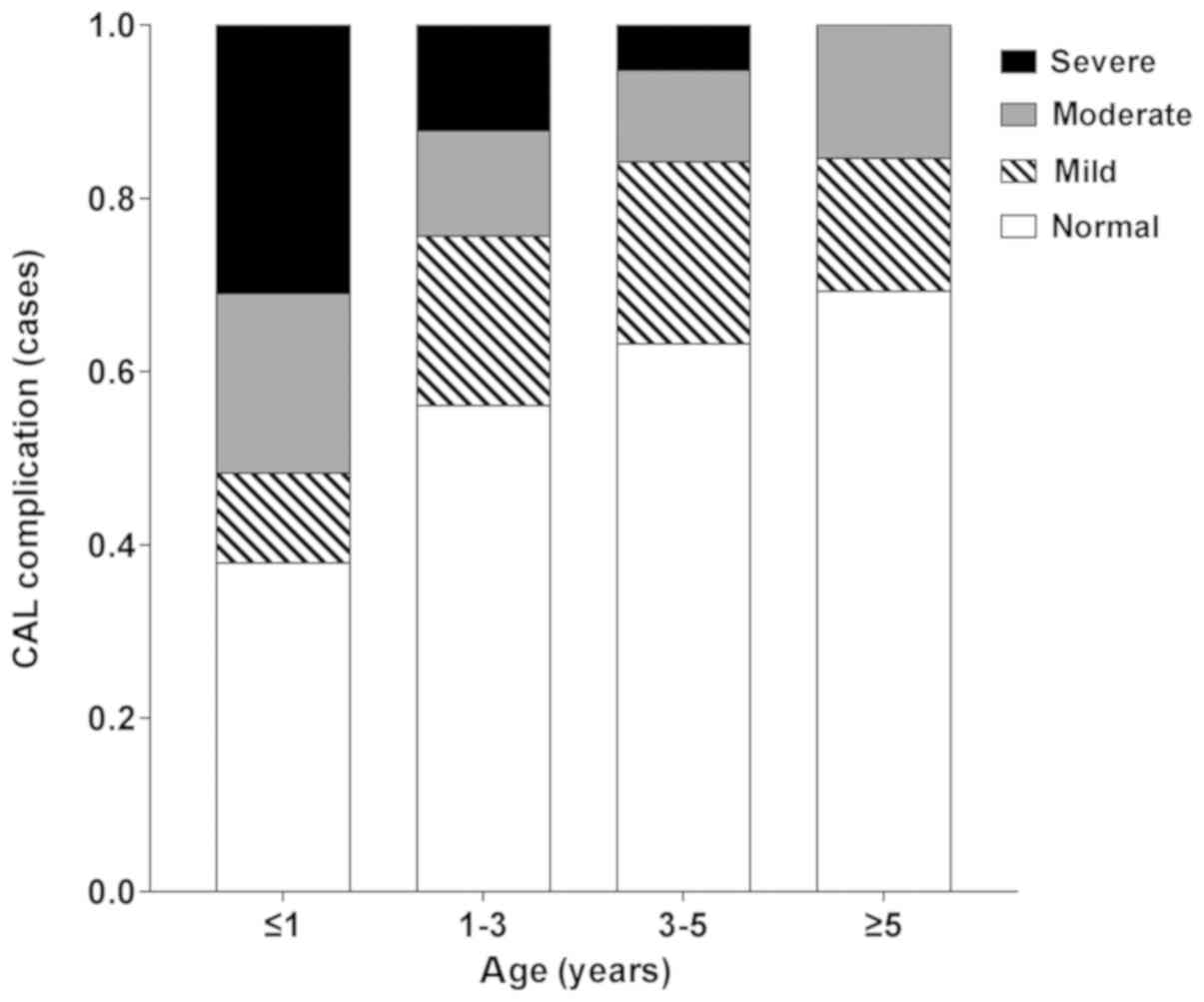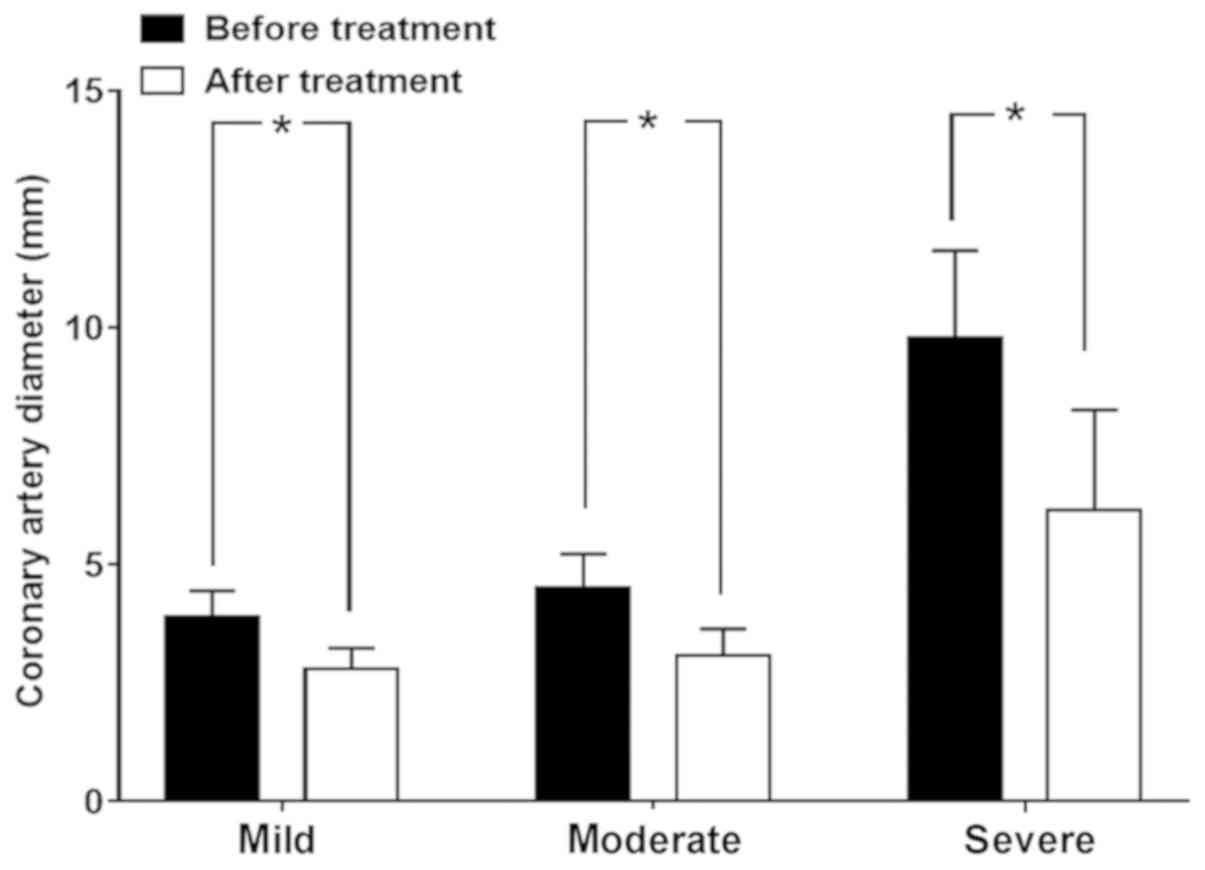|
1
|
Singh S, Vignesh P and Burgner D: The
epidemiology of Kawasaki disease: A global update. Arch Dis Child.
100:1084–1088. 2015.PubMed/NCBI View Article : Google Scholar
|
|
2
|
Hedrich CM, Schnabel A and Hospach T:
Kawasaki Disease. Front Pediatr 6. 198:2018. View Article : Google Scholar
|
|
3
|
JCS Joint Working Group: Guidelines for
diagnosis and management of cardiovascular sequelae in Kawasaki
disease (JCS 2013). Digest version. Circ J 78: 2521-2562, 2014.
|
|
4
|
McCrindle BW and Cifra B: The role of
echocardiography in Kawasaki disease. Int J Rheum Dis. 21:50–55.
2018.PubMed/NCBI View Article : Google Scholar
|
|
5
|
Argyropoulou OD, Protogerou AD and
Sfikakis PP: Accelerated atheromatosis and arteriosclerosis in
primary systemic vasculitides: Current evidence and future
perspectives. Curr Opin Rheumatol. 30:36–43. 2018.PubMed/NCBI View Article : Google Scholar
|
|
6
|
Kato M, Ayusawa M, Watanabe H, Komori A,
Abe Y, Nakamura T, Kamiyama H and Takahashi S: Cardiac function on
3-D speckle tracking imaging and cytokines in Kawasaki disease.
Pediatr Int (Roma). 60:342–348. 2018.PubMed/NCBI View Article : Google Scholar
|
|
7
|
Singh S, Jindal AK and Pilania RK:
Diagnosis of Kawasaki disease. Int J Rheum Dis. 21:36–44.
2018.PubMed/NCBI View Article : Google Scholar
|
|
8
|
Pilania RK, Bhattarai D and Singh S:
Controversies in diagnosis and management of Kawasaki disease.
World J Clin Pediatr. 7:27–35. 2018.PubMed/NCBI View Article : Google Scholar
|
|
9
|
Newburger JW, Takahashi M, Gerber MA,
Gewitz MH, Tani LY, Burns JC, Shulman ST, Bolger AF, Ferrieri P,
Baltimore RS, et al: Committee on Rheumatic Fever, Endocarditis,
and Kawasaki Disease, Council on Cardiovascular Disease in the
Young, American Heart Association: Diagnosis, treatment, and
long-term management of Kawasaki disease: A statement for health
professionals from the Committee on Rheumatic Fever, Endocarditis,
and Kawasaki Disease, Council on Cardiovascular Disease in the
Young, American Heart Association. Pediatrics. 114:1708–1733.
2004.PubMed/NCBI View Article : Google Scholar
|
|
10
|
Ravekes WJ, Colan SD, Gauvreau K, Baker
AL, Sundel RP, van der Velde ME, Fulton DR and Newburger JW: Aortic
root dilation in Kawasaki disease. Am J Cardiol. 87:919–922.
2001.PubMed/NCBI View Article : Google Scholar
|
|
11
|
Noto N, Komori A, Ayusawa M and Takahashi
S: Recent updates on echocardiography and ultrasound for Kawasaki
disease: Beyond the coronary artery. Cardiovasc Diagn Ther.
8:80–89. 2018.PubMed/NCBI View Article : Google Scholar
|
|
12
|
Ha KS, Jang GY, Lee J, Lee KC and Son CS:
Laboratory Markers in Incomplete Kawasaki Disease according to
Coronary Artery Outcome. Korean Circ J. 48:287–295. 2018.PubMed/NCBI View Article : Google Scholar
|
|
13
|
Cameron SA, Robinson JD, Carr MR and Patel
A: Giant coronary artery aneurysms in an infant with Kawasaki
disease: Evaluation by echocardiography and computed tomographic
angiography. Echocardiography. 35:1692–1694. 2018.PubMed/NCBI View Article : Google Scholar
|
|
14
|
de Ferranti SD, Gauvreau K, Friedman KG,
Tang A, Baker AL, Fulton DR, Tremoulet AH, Burns JC and Newburger
JW: Association of Initially Normal Coronary Arteries With Normal
Findings on Follow-up Echocardiography in Patients With Kawasaki
Disease. JAMA Pediatr. 172(e183310)2018.PubMed/NCBI View Article : Google Scholar
|
|
15
|
Dionne A and Dahdah N: Myocarditis and
Kawasaki disease. Int J Rheum Dis. 21:45–49. 2018.PubMed/NCBI View Article : Google Scholar
|
|
16
|
Li W, Zhang L, Huang P and Zhang Z:
Clinical features and mid-term follow-up in infants younger than 3
months with Kawasaki disease in a Chinese population. J Paediatr
Child Health. 55:523–527. 2019.PubMed/NCBI View Article : Google Scholar
|
|
17
|
Cameron SA, Carr M, Pahl E, DeMarais N,
Shulman ST and Rowley AH: Coronary artery aneurysms are more severe
in infants than in older children with Kawasaki disease. Arch Dis
Child. 104:451–455. 2019.PubMed/NCBI View Article : Google Scholar
|
|
18
|
Toyono M, Takagi D, Oyamada J, Shimada S,
Aoki-Okazaki M and Takahashi T: Coronary artery aneurysm after
kawasaki disease in a single coronary artery. Circ J. 77:2409–2411.
2013.PubMed/NCBI View Article : Google Scholar
|
|
19
|
Baek JY and Song MS: Meta-analysis of
factors predicting resistance to intravenous immunoglobulin
treatment in patients with Kawasaki disease. Korean J Pediatr.
59:80–90. 2016.PubMed/NCBI View Article : Google Scholar
|
|
20
|
Kim MK, Song MS and Kim GB: Factors
Predicting Resistance to Intravenous Immunoglobulin Treatment and
Coronary Artery Lesion in Patients with Kawasaki Disease: Analysis
of the Korean Nationwide Multicenter Survey from 2012 to 2014.
Korean Circ J. 48:71–79. 2018.PubMed/NCBI View Article : Google Scholar
|
|
21
|
Maggio MC, Corsello G, Prinzi E and Cimaz
R: Kawasaki disease in Sicily: Clinical description and markers of
disease severity. Ital J Pediatr. 42(92)2016.PubMed/NCBI View Article : Google Scholar
|
|
22
|
Lee SH, Song ES, Yoon S, Hong S, Cho HJ,
Yang EM, Eom GH, Kang G and Cho YK: Usefulness of Age-Stratified
N-Terminal Prohormone of Brain Natriuretic Peptide for Diagnosing
Kawasaki Disease. Dis Markers. 2017(6263121)2017.PubMed/NCBI View Article : Google Scholar
|
|
23
|
Dionne A and Dahdah N: A Decade of
NT-proBNP in Acute Kawasaki Disease, from Physiological Response to
Clinical Relevance. Children (Basel). 5(E141)2018.PubMed/NCBI View Article : Google Scholar
|
|
24
|
Sato YZ, Molkara DP, Daniels LB, Tremoulet
AH, Shimizu C, Kanegaye JT, Best BM, Snider JV, Frazer JR, Maisel
A, et al: Cardiovascular biomarkers in acute Kawasaki disease. Int
J Cardiol. 164:58–63. 2013.PubMed/NCBI View Article : Google Scholar
|
|
25
|
Satoh K, Wakejima Y, Gau M, Kiguchi T,
Matsuda N, Takasawa R, Takasawa K, Nishioka M and Shimohira M: Risk
of coronary artery lesions in young infants with Kawasaki disease:
Need for a new diagnostic method. Int J Rheum Dis. 21:746–754.
2018.PubMed/NCBI View Article : Google Scholar
|
|
26
|
Liu W, Liu C, Zhang L, Xie X, Gu X, Sang
C, Xu M, Xu W and Jia H: Molecular basis of coronary artery
dilation and aneurysms in patients with Kawasaki disease based on
differential protein expression. Mol Med Rep. 17:2402–2414.
2018.PubMed/NCBI View Article : Google Scholar
|
|
27
|
Chen J, Liu Y, Liu W and Wu Z: A
meta-analysis of the biomarkers associated with coronary artery
lesions secondary to Kawasaki disease in Chinese children. J
Huazhong Univ Sci Technolog Med Sci. 31:705–711. 2011.PubMed/NCBI View Article : Google Scholar
|
|
28
|
Jeon SK, Kim G, Ko H, Byun JH and Lee HD:
Risk factors for the Occurrence and Persistence of Coronary
Aneurysm in Kawasaki Disease. Korean J Pediatr. 62:138–143.
2019.PubMed/NCBI View Article : Google Scholar
|
|
29
|
Kim HJ, Choi EH, Lim YJ and Kil HR: The
Usefulness of Platelet-derived Microparticle as Biomarker of
Antiplatelet Therapy in Kawasaki Disease. J Korean Med Sci.
32:1147–1153. 2017.PubMed/NCBI View Article : Google Scholar
|
















